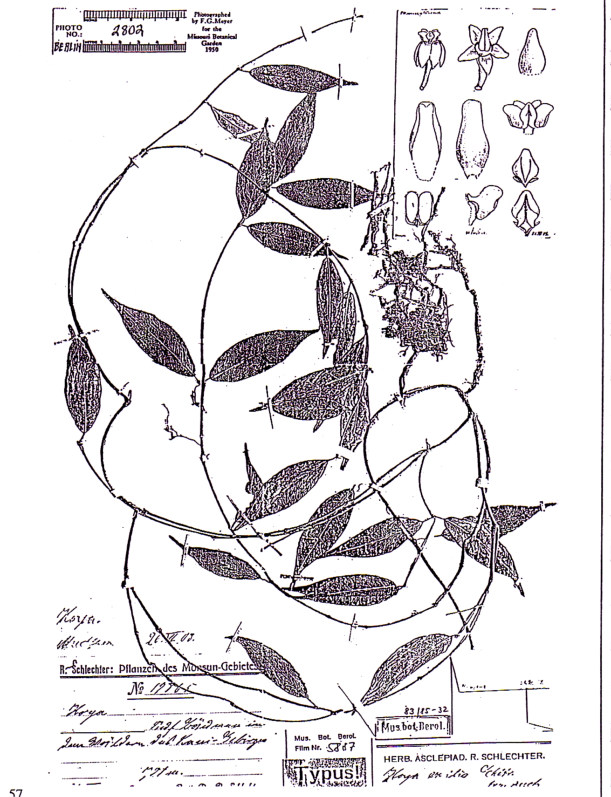
Hoya elmeri Merrill 1929
Type description:
In University of California Publications in Botany 15 (1929) 258. E. D. Merrill. Hoya elmeri Sp. nov. § Eu-hoya. Scandens, floribus exceptis glabra, caulibus teretibus; 5 ad 6 mm diametro, ramis paucis, levibus, circiter 3mm diametro, saepe radicantibus, internodiis usque ad 12 cm longis: foliis oppositis, carnosis. in siccitate coriaceis. penninerviis, subellipticis, 11 ad 15 cm longis, 5 ad 6.5 cm latis. in siccitate pallidis, utrinque concoloribus. vix verruculosis, utrinque subaequaliter angustatis, basi acutis, apice acutis ad breviter obscureque acuminatis, nervis primariis utrinque circiter 7, tenuibus, distantibus. distinctis vel interdum subindistinctis, arcuato-anastomosantibus, reticulis laxis; petiolo crasso, circiter 1 cm longo; umbellis pendulis, pedunculo saltem 3.5 cm longo, circiter 1.5 mm crasso, glabro, pedicellis circiter 1.5 cm longis; floribus rubidis, 10 ad 12 mm diametro, rotatis, sepalis late ovatis, rotundatis, tenuibus, glabris, circiter 1.3 mm longis; corolla extus glabra intus villosa, lobis patulis vel recurvatis, latissimis, circiter 3mm longis et 5 mm latis, nee profunde 3-lobatis, lobis lateralibus late rotundatis, aliis acutis; corona circiter 6.5 mm diametro, processibus corneis, patulis vel leviter adscendentibus, acutis vel subacutis, compressis, circiter 3.5 mm longis, margine superiore subcarinato, haud plano. Elmer 20652, near Tawao. Scandent in dense thickets among large boulders in densely forested ravines, the flowers very dark red, easily falling.
I have not been able to refer this to any of the described species of this rather difficult genus. It is characterized by its rather small, dark red flowers, and its distinctly pinnately nerved, subelliptic leaves which are subequally narrowed to both the acute base and apex.
Translation: Climbing, glabrous except for the flowers, stalk round, 5 to 6 mm. in diameter, branches few, smooth, about 3 mm in diameter, often rooting, internodes up to 12 cm. long; leaves opposite, fleshy, when dry leathery, penninerved, somewhat elliptic, 11 to 15 cm long, 5 to 6.5 cm wide, when dry pale, both sides the same color, sparsely covered with small wort-like growths, both ends equally narrow, base acute, apex acute to briefly and obscurely acuminate, primary nerves on both sides of the costa 7, slender, distinct or sometimes somewhat indistinct, curved anastomosing, loosely reticulated; petiole thick, about 1 cm long; fleshy, glabrous 1.3 mm. long, corolla outside glabrous, inside silky, lobes spreading or recurved, very broad, about 3 mm. long and 5 mm. wide, not deeply 3 lobed, sides of lobes broadly rounded, others acute; corona about 6.5 mm in diameter, processes horny, spreading or slightly ascending, acute or somewhat acute, compressed, about 3.5 mm long, margines above somewhat keeled, not all flat.
Other literature:
In Sunyatsenia 3. 2/3 (1934) 175. Tsiang. Hoya Elmeri Merrill in Univ. Calif. Publ. Bot. 15: 258. (Pl. Elmer. Born.) 1929. Borneo: Near Tawao, A. D. E. Elmer 20652, Oct., 1922 - March, 1923. Endemic. Of this, we have a sterile twig and there detached flowers, which enable me to place it here. The most interesting thing in this species is that the coronal-lobes are very long, surpassing the sinus of the corolla-lobes. Otherwise, it closely resembles H. carnosa.
Hoya elmeri Merrill 1929

Hoya elmeri Merrill Type # 20652 (NY)
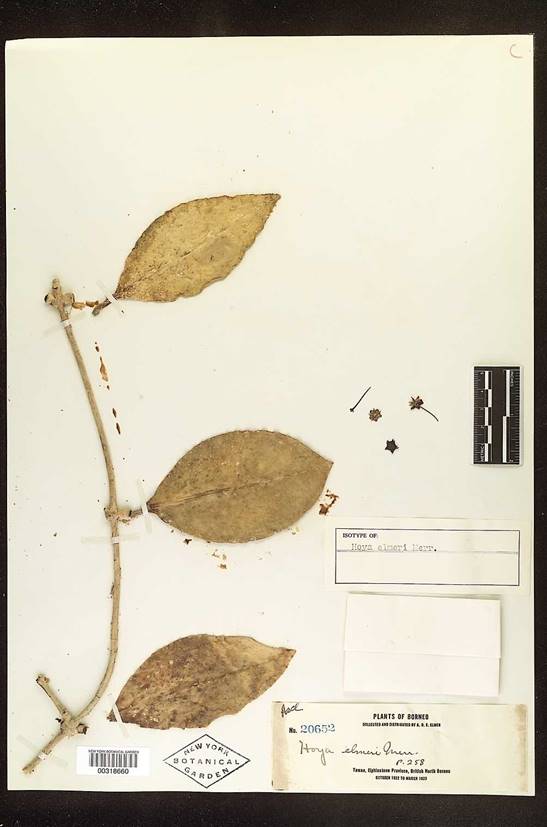
Hoya elmeri Merrill Isotype # 20652 (BISH)
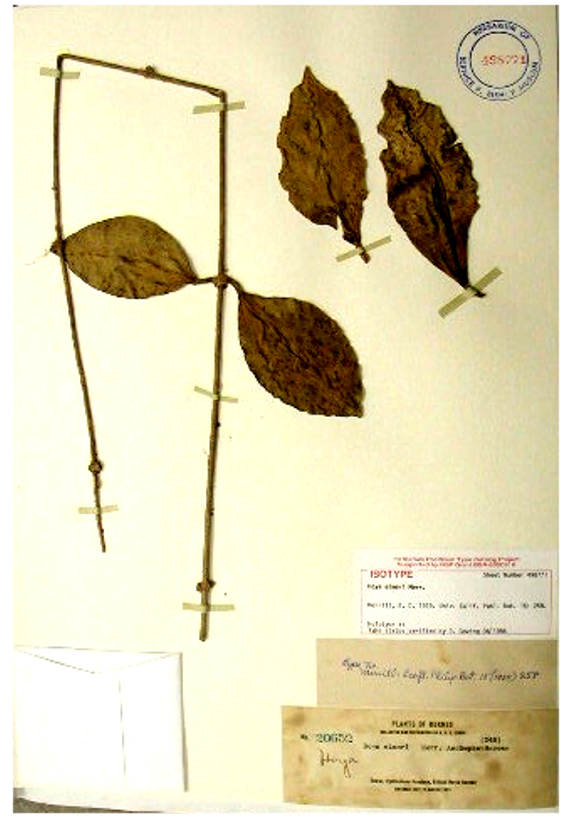
Hoya elmeri Merrill Type # 20652
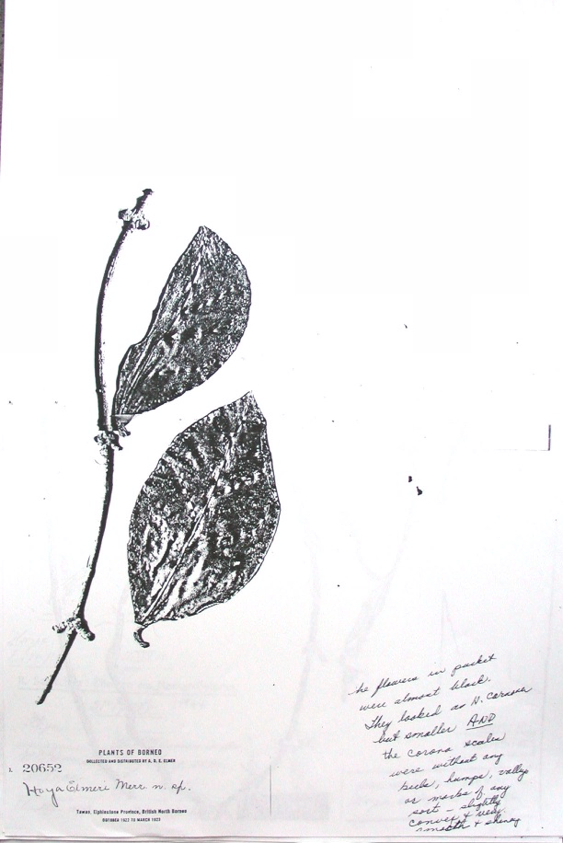
Hoya elmeri Merrill # 20652 (DS)
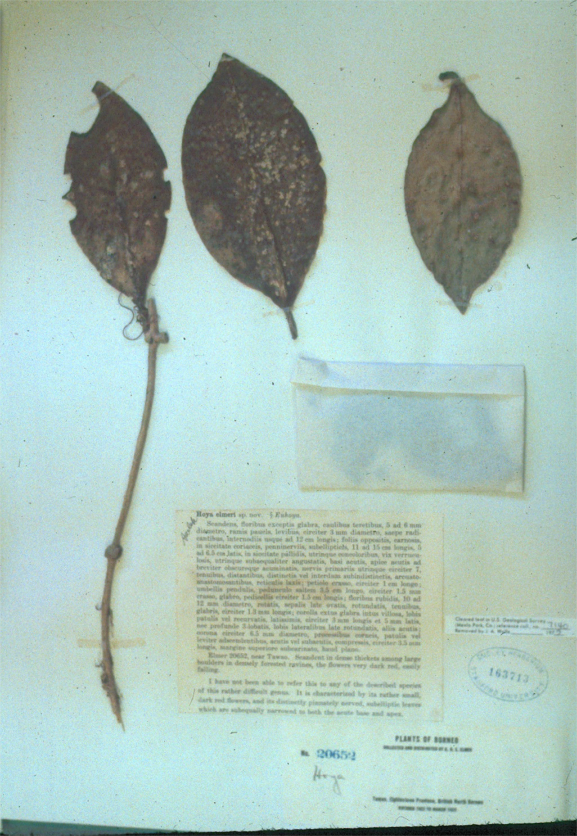
Hoya elmeri Schlechter # 8896 (B)
In Dr. Schlechter’s Hoya Species. (1993) 58. R. D. Kloppenburg. Hoya elmeri Schlechter (unpublished). This species is not the same species as Hoya elmeri Merrill, which was collected near Sandakan in North Borneo. This species was never published so there is no Latin description. The sheet is in the Berlin Herbarium, Germany.
